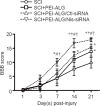Nischarin-siRNA delivered by polyethylenimine-alginate nanoparticles accelerates motor function recovery after spinal cord injury
- PMID: 29171434
- PMCID: PMC5696850
- DOI: 10.4103/1673-5374.217348
Nischarin-siRNA delivered by polyethylenimine-alginate nanoparticles accelerates motor function recovery after spinal cord injury
Abstract
A previous study by our group found that inhibition of nischarin promotes neurite outgrowth and neuronal regeneration in Neuro-2a cells and primary cortical neurons. In recent years, more and more studies have shown that nanomaterials have good prospects in treatment of spinal cord injury. We proposed that small interfering RNA targeting nischarin (Nis-siRNA) delivered by polyethyleneimine-alginate (PEI-ALG) nanoparticles promoted motor function recovery in rats with spinal cord injury. Direct microinjection of 5 μL PEI-ALG/Nis-siRNA into the spinal cord lesion area of spinal cord injury rats was performed. From day 7 after surgery, Basso, Beattie and Bresnahan score was significantly higher in rats from the PEI-ALG/Nis-siRNA group compared with the spinal cord injury group and PEI-ALG/Control-siRNA group. On day 21 after injection, hematoxylin-eosin staining showed that the necrotic area was reduced in the PEI-ALG/Nis-siRNA group. Immunohistochemistry and western blot assay results confirmed successful inhibition of nischarin expression and increased protein expression of growth-associated protein-43 in the PEI-ALG/Nis-siRNA group. These findings suggest that a complex of PEI-ALG nanoparticles and Nis-siRNA effectively suppresses nischarin expression, induces expression of growth-associated protein-43, and accelerates motor function recovery after spinal cord injury.
Keywords: alginate; growth-associated protein-43; motor function; nanoparticles; necrotic area; nerve regeneration; neural regeneration; nischarin; polyethylenimine; small interfering RNA; spinal cord injury.
Conflict of interest statement
None declared
Figures





Similar articles
-
Contribution of Nischarin/IRAS in CNS development, injury and diseases.J Adv Res. 2023 Dec;54:43-57. doi: 10.1016/j.jare.2023.01.020. Epub 2023 Jan 27. J Adv Res. 2023. PMID: 36716956 Free PMC article. Review.
-
Local injection of bone morphogenetic protein 7 promotes neuronal regeneration and motor function recovery after acute spinal cord injury.Neural Regen Res. 2018 Jun;13(6):1054-1060. doi: 10.4103/1673-5374.233449. Neural Regen Res. 2018. PMID: 29926833 Free PMC article.
-
Endothelial progenitor cell-conditioned medium promotes angiogenesis and is neuroprotective after spinal cord injury.Neural Regen Res. 2018 May;13(5):887-895. doi: 10.4103/1673-5374.232484. Neural Regen Res. 2018. PMID: 29863020 Free PMC article.
-
Low-energy extracorporeal shock wave therapy promotes vascular endothelial growth factor expression and improves locomotor recovery after spinal cord injury.J Neurosurg. 2014 Dec;121(6):1514-25. doi: 10.3171/2014.8.JNS132562. Epub 2014 Oct 3. J Neurosurg. 2014. PMID: 25280090
-
Targeted Inhibition of Leucine-Rich Repeat and Immunoglobulin Domain-Containing Protein 1 in Transplanted Neural Stem Cells Promotes Neuronal Differentiation and Functional Recovery in Rats Subjected to Spinal Cord Injury.Crit Care Med. 2016 Mar;44(3):e146-57. doi: 10.1097/CCM.0000000000001351. Crit Care Med. 2016. PMID: 26491860
Cited by
-
siRNA Therapeutics: Future Promise for Neurodegenerative Diseases.Curr Neuropharmacol. 2021;19(11):1896-1911. doi: 10.2174/1570159X19666210402104054. Curr Neuropharmacol. 2021. PMID: 33797386 Free PMC article. Review.
-
Ferroptosis-related genes participate in the microglia-induced neuroinflammation of spinal cord injury via NF-κB signaling: evidence from integrated single-cell and spatial transcriptomic analysis.J Transl Med. 2025 Jan 11;23(1):43. doi: 10.1186/s12967-025-06095-0. J Transl Med. 2025. PMID: 39799354 Free PMC article.
-
Nanotechnology-Assisted RNA Delivery: From Nucleic Acid Therapeutics to COVID-19 Vaccines.Small Methods. 2021 Sep 15;5(9):e2100402. doi: 10.1002/smtd.202100402. Epub 2021 Jul 28. Small Methods. 2021. PMID: 34514087 Free PMC article. Review.
-
Contribution of Nischarin/IRAS in CNS development, injury and diseases.J Adv Res. 2023 Dec;54:43-57. doi: 10.1016/j.jare.2023.01.020. Epub 2023 Jan 27. J Adv Res. 2023. PMID: 36716956 Free PMC article. Review.
-
Strategies for Oligodendrocyte and Myelin Repair in Traumatic CNS Injury.Front Cell Neurosci. 2021 Jan 11;14:619707. doi: 10.3389/fncel.2020.619707. eCollection 2020. Front Cell Neurosci. 2021. PMID: 33505250 Free PMC article. Review.
References
-
- Acharya R, Saha S, Ray S, Hazra S, Mitra MK, Chakraborty J. siRNA-nanoparticle conjugate in gene silencing: a future cure to deadly diseases? Mater Sci Eng C Mater Biol Appl. 2017;76:1378–1400. - PubMed
-
- Baptiste DC, Tighe A, Fehlings MG. Spinal cord injury and neural repair: focus on neuroregenerative approaches for spinal cord injury. Exp Opin Investig Drugs. 2009;18:663–673. - PubMed
LinkOut - more resources
Full Text Sources
Other Literature Sources

